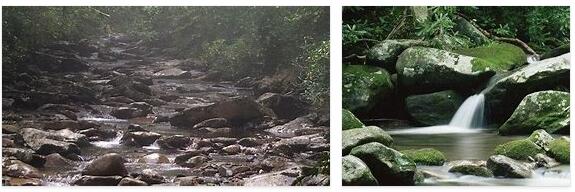The Smoky Mountains in the southern Appalachian Mountains are a jungle landscape with an extraordinary variety of plants and animals. The mist rising from the valleys gave the region its name. There are more than 3500 plant species, including 130 tree species, at heights of up to 2025 m. Deer, marmots, black bears and more than 200 species of birds cavort on the wooded mountain slopes.
Great Smoky Mountains National Park: Facts
| Official title: | Great Smoky Mountains National Park |
| Natural monument: | National park since 1926 and part of the Southern Appalachian Biosphere Reserve since 1988; 2090 km²; Altitudes from 259 m to 2025 m, including the Great Smoky Mountains with peaks over 1818 m, geologically consisting of gneiss, schist and sedimentary rock, 14 different forest types |
| Continent: | America |
| Country: | USA, Tennessee / North Carolina |
| Location: | southern end of the Appalachian Mountains; bounded by the Little Tennessee River, French Broad River and Pigeon River |
| Appointment: | 1983 |
| Meaning: | With around 4000 plant species, it is a refuge for the flora of temperate latitudes before the time of human settlement and a habitat for the greatest diversity of salamanders in the world |
| Flora and fauna: | Vegetation with conifers, heathland and wet meadows, around 4000 plant species, including 1500 flowering plants, over 100 tree species such as sugar maple, tulip tree and late blooming bird cherry, as well as rhododendrons such as rhododendron catawbiense and R. minus, 15 plant species are considered endangered; 66 different mammal species such as black bear, red and gray fox, opossum, raccoon, gray squirrel, North American flying squirrel; Over 200 bird species, 7 turtle, 8 lizard, 30 salamander species such as the dwarf brook salamander, which only occurs in this national park, and the giant salamander, as well as 23 species of snakes, more than 50 species of fish; 2001 experimental settlement of elk |
In the Cherokee hunting grounds
Delicately breathed blue haze lies ghostly in the Appalachian valleys, clings to the slopes of the up to 2000 m high mountains, covers the forests like a mysterious veil and only slowly gives way to the rays of the morning sun – no industrial fumes, but banks of fog envelop the Great Smoky Mountains National Park a. This weather phenomenon gave the mountain region its name. Even the Cherokee Indians, the natives of this region, called this mountain world, in whose lowlands deciduous forests dominate, in their language “Shaconage”, which means something like “constantly blue veil”.
In 1926 the region was declared a national park after conservationists had tried to do so years earlier. Thanks to sufficient donations – the American entrepreneur John Davison Rockefeller alone quickly topped up the donation pot by four million dollars – it was possible to buy up private farmland in order to bring it to the national park.
This national park has long since taken over the studio bosses from far-off Hollywood and keeps flickering as a backdrop across the world’s canvases: In »Nell«, Jodie Foster grew up, as it were as female Kaspar Hauser, far from civilization in the wilderness of the »blue veil«. and in the remake of “The Last of the Mohicans”, Daniel Day-Lewis insisted on his adventures in the “Great Smokies” in the role of Chingachgook companion Hawkeye.
To visit most of the national park you have to do without the car. Only a few roads open up the mountain range, which was formed in the Paleozoic and only unfolded into its present form in its northern area during the last Ice Age. The region is very well developed for hikers with a network of 1,440 kilometers of marked trails. Initiated nature lovers are enthusiastic in their own way about the 114 kilometer long long distance hiking trail, the Appalachian Trail, that runs through the national park.
Every year a good ten million people pass the main gates of the national park near Gatlinburg in the north and Cherokee in the south – mainly city dwellers from the east coast metropolises who are drawn to nature.
If you let your gaze wander over the gently rolling valleys, you think you are immersed in the contemplative world of Disney’s Bambi: the landscape seems serene, light, even a little lively. Marmots crouch on the path and hide from approaching hikers like small children by clapping their paws over their eyes – according to the motto “I don’t see you, you don’t see me either”. It is a peaceful world with the greatest possible silence not far from the concrete jungle of the megacities – pure nature without industrial complexes and castles, without straightened rivers or huge electricity pylons, but with the twittering of birds instead of noisy background noise.
Very rare orchids, wild azaleas and mountain magnolias are the splash of color in the middle of a lush green. Black bears and lynx roam in the thick forests. The beaver tirelessly builds his castle. With a little luck you can see eagles with outspread wings high above the valleys soaring through the air.
Although no red-brown canyons like in the John Wayne films can be seen far and wide, everything that belongs to the knitting pattern of transfigured Wild West romanticism can be found here: Indians, lonely settler houses, crystal-clear lakes and terrifying white water rivers. The “Great Smokies” were the traditional hunting grounds of the Cherokee Indians who lived here, who used blowguns instead of bows and arrows to hunt eagles, whose tail feathers they used as ceremonial decorations for their winter eagle dances. Several thousand sons and daughters of this Indian people still live near the national park today.
